Automodello 1967 Gurney-Weslake Eagle Mk1 V-12: A Grand Prix great’s historic Spa winner

Much has been written about the greatness of Dan Gurney—including quite a bit here in the pages of Die Cast X. He is considered by many (and count yours truly among them) to be the greatest American racing driver of all time. He was a renaissance master whose chosen instrument was the steering wheel. He was competitive in anything he drove. He was the first driver ever to win in each of the four major racing series—Formula 1, Le Mans, Indycar and NASCAR (a feat only achieved twice since)—as well as in many “lesser” series like Trans-Am and Can-Am. He is the only man ever to score the first win for three different Formula One constructors—Porsche, Brabham, and Eagle. He was a technical pioneer, inventing the “Gurney flap”—an aerodynamic miracle device which has been used on virtually every race car for the past 45 years. He was a safety innovator—introducing the full-face helmet to F1. He was a colossus of car culture—inventing the tradition of spraying champagne in the winner’s circle, and the first-ever winner of the Cannonball Baker Sea-To-Shining-Sea Memorial Trophy Dash (better known as the Cannonball Run). Taken altogether, those achievements easily earn Dan Gurney the distinction of being the greatest American driver ever.
At a Glance
Model: 1967 Gurney-Weslake Eagle Mk1
Manufacturer: Automodello
Genre: Classic Formula 1 racer
Scale: 1:12
Item no. 12A01S
Price: To be announced
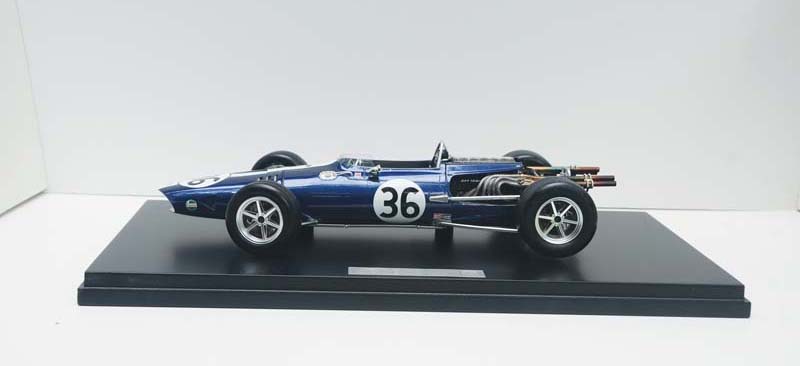
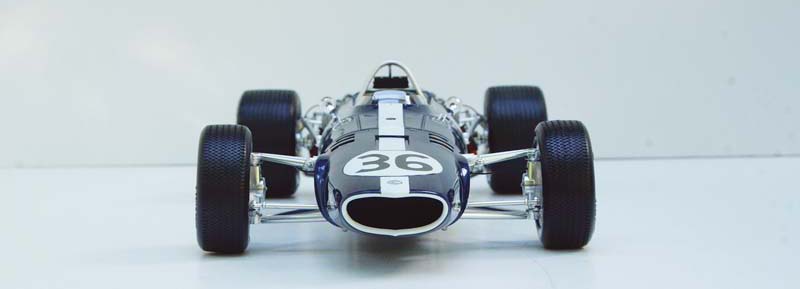
Of course, Gurney was also a tremendously successful race car builder and team owner. He founded the All American Racers (AAR) team with fellow racing legend Carroll Shelby in 1964, establishing the Eagle marque, countless versions of which have won in sports car, Indycar and F1. It came about because the Goodyear Tire & Rubber company approached Gurney and Shelby about developing a Goodyear-shod Indycar to take on the dominant Firestone equipped teams. As part of the negotiation Gurney also secured Goodyear support to develop a version of the car—named the Eagle Mk1—to campaign in F1. Gurney commissioned British firm Weslake Engineering to develop a bespoke 3.0L V-12 for the F1 car, while the Indy effort would be powered by Ford. In deference to the British engine the F1 branch of the team was referred to as “Anglo American Racers.”
The Weslake V-12 was finally ready by the second event of the 1967 F1 season—the prestigious Race of Champions at Brands Hatch in March. The V-12’s 400+ horsepower matched anything on the track and Gurney started things off n spectacular fashion by taking the pole, setting fast lap and winning the race! Unfortunately, it was not a points-scoring event for the F1 Championship, and the next points race—Monaco—was almost two months away. So Gurney carried his momentum back stateside into Trans-Am where he debuted another new car—Mercury’s Cougar—with a win at Green Valley before heading back to F1. The Weslake V-12 was powerful, but its complexity made it fragile and the Eagle Mk1 was heavier than many of its competitors, so Gurney was unable to repeat his success in Monaco. Then it was back to the US to qualify for the Indy 500 just a week later. Gurney put the Indy-spec Eagle on the front row just behind pole-sitter Mario Andretti, and on race day Gurney ran in the top 5 most of the day, even leading some laps, before dropping out with just 40 to go. The speed was encouraging—but ultimately a disappointing result.

Like most Automodello models the Eagle comes with a display base and etched metal plaque. It also comes with a matching acrylic cover which, while making a first-class presentation, creates too many reflections to photograph!
Then it was a whirlwind trip back to Europe for the Dutch Grand Prix just four days later! The F1 crew had been busy, bringing a new lighter Eagle chassis that swapped several aluminum components for magnesium, along with a gorgeous new titanium exhaust system. Gurney matched his Indy qualifying effort with another 2nd place grid spot but more engine problems took him out of the race early. Gurney had no time to dwell on his misfortune. Just a week later he was off to France for the 24 Hours of Le Mans and a drive in the wild Ford GT40 Mark IV with teammate AJ Foyt. They led from pole and set speed and distance records on their way to a dominant win, and it was on the winner’s podium at Le Mans where Gurney first sprayed champagne in celebration, inventing one of racing’s most visible traditions in one spontaneous moment of joy.
The champagne was barely dry on Gurney’s driving suit when he arrived at Spa-Francorchamps a week after Le Mans for the Belgian Grand Prix. The high-speed Spa circuit suited the Weslake horsepower and for the third time in four races Gurney qualified 2nd. Gurney trailed Jackie Stewart after losing precious time in the pits but then cracked off a series of record-shattering laps, catching and passing Stewart with 8 laps to go and rocketing off to the Eagle’s first points-earning win, and the first—and still the only—F1 points race victory ever for an American driver in a car of his own manufacture, capping what may be the greatest month for one driver in motor racing history.
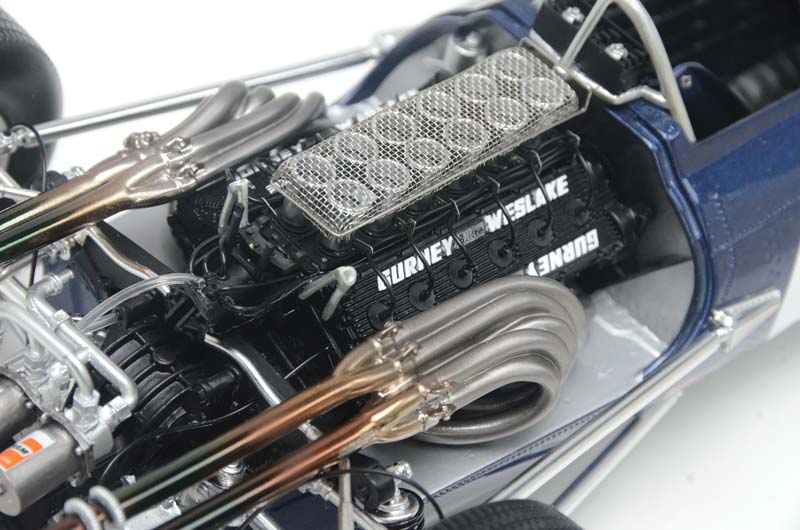
The Weslake V-12 made excellent horsepower, and the titanium exhaust headers are a work of art. The model’s interpretation of them is exquisite, with realistic rainbow heat discoloration on the collector pipes. The mesh screen over the induction stacks is excellent as well.
So then, the historical significance of the Gurney-Weslake Eagle Mk1 is unimpeachable. But that is only part of the appeal, because the car is also among the most beautiful Grand Prix cars from one of the most exciting racing eras of all time. The car was designed by Len Terry who also penned the Indy-winning Lotus 38, and the Eagle shares many similar traits including a monocoque chassis to which the suspension is directly mounted. But subtle details like the “eagle’s beak” shape to the front air inlet and the graceful sweep to the fairings over the engines are just prettier than the Lotus. The graceful shape is emphasized by the paint. In this era before major sponsor liveries F1 cars still adhered to color schemes corresponding to national origin. American teams used blue and white, and the deep blue primary color has a fine metallic sheen. Interestingly, the car’s number—36—corresponded to Gurney’s age during the 1967 season. There was a mirror missing on this example, but otherwise the fit and finish is outstanding and Automodello overnighted me a replacement mirror. With the included display base etched with the Gurney eagle’s head logo (matching the one on the car’s nose) and an acrylic dust cover the model delivers a first-class presentation for this hand-built beauty.
Gurney was unusually tall for a racing driver—his 6-foot 3-inch frame was a tight squeeze in an F1 car, requiring him to sit with his knees uncomfortably bent. The cockpit of the Eagle Mk1 has pleated leather padding on the sides of the cockpit to provide comfort and insulation on the sides of the monocoque which housed the fuel tanks. The model depicts this unusual feature right down to the snaps that affixed the padding. There is a set of detailed instruments on the tiny dash and delicate little supplementary air deflector on the windscreen, just as on the real car. It is riveted into the primary windscreen, no doubt because Gurney’s height put his helmet’s visor into the dirty airflow coming across the Eagle’s nose.

Somehow Dan Gurney squeezed his 6’3” frame into this tiny cockpit. The model has beautiful gauges and replicates the leather padding fixed to the sides of the mostly magnesium monocoque.
Because the same basic chassis would need to carry different powerplants depending on the series (the Weslake V-12 for F1 or a Ford V-8 for Indy) the engine sits in a cradle rather than serve as a stressed member, which contributed to its extra weight. The work-of-art titanium exhaust system offset some of those extra pounds. The model depicts the exquisite quartet of 3-into-1 headers with their rainbow heat discoloration that is visible on photos of the actual car, and when you remove the fairings that sit atop the cylinder heads you get an even better view of them. Just as impressive is the intricate suspension. The tubular lower A-arms, coil-over shocks, and the spindly antiroll bar on its long pushrods are all meticulously rendered. The twin oil filters on the back of the engine have Fram logos on them but the plumbing to them is missing a couple of oil lines. There are clear fuel lines running from the fuel filter and pump up to the intake and the fuel injection trumpets look fabulous under their wire mesh screens. There are scale-thickness plug wires in the ignition system.
The special 6-spoke 15-inch magnesium wheels are very accurately molded. The tires are accurate renderings of period race tires down to the size markings. There’s also a little crest that looks a lot like a Firestone badge. Technically they should probably be Goodyears since it was that company that underwrote the AAR team, but in the absence of brand licensing the shape, size and tread pattern of these tires look right.
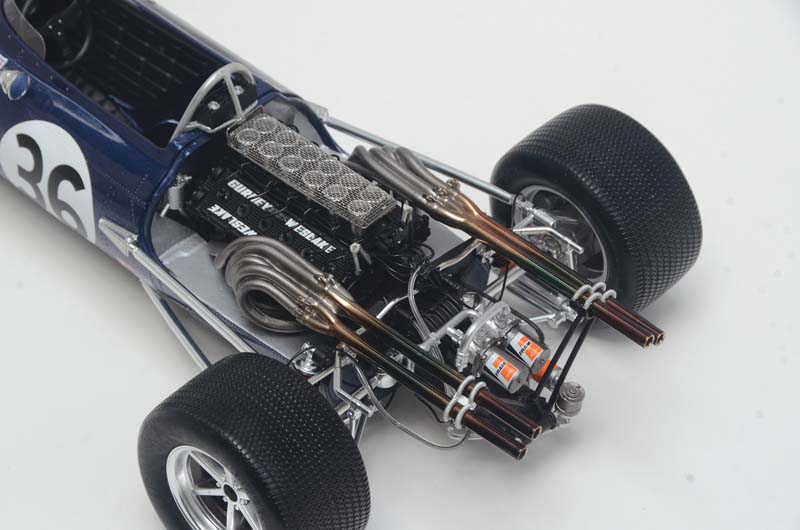
The V-12 sits in a cradle rather than serve as a stressed member in the chassis, allowing it to be swapped for a Ford V-8 when running at Indy. The model’s rear suspension is nearly as pretty as the engine, and check out those Fram oil filters!
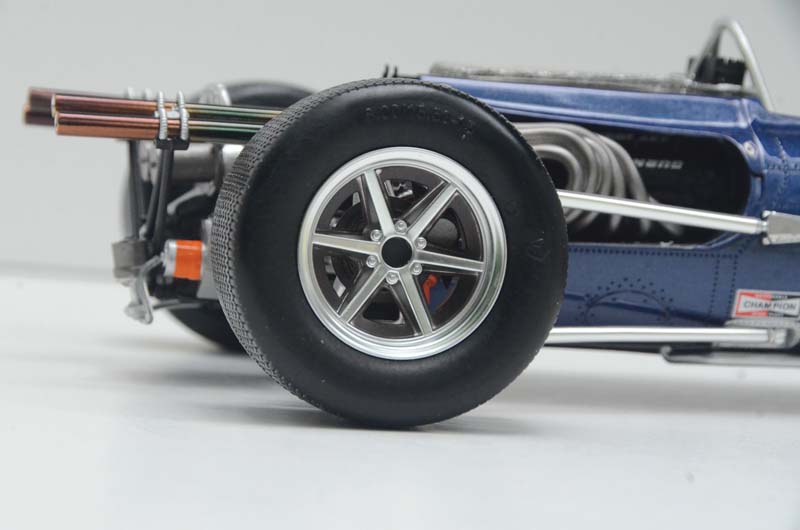
The magnesium 6-spoke wheels are nicely molded, and while the tires lack brand markings on the sidewalls there are size markings and a little badge that looks quite similar to a Firestone logo.
What we like
+ One-of-a-kind racing provenance
+ Exceptional engine detail
+ Display case gives first-class presentation
FINAL THOUGHTS
Dan Gurney was a racing hero to millions of fans. Including me. His racing résumé is overflowing with extraordinary accomplishments, but none more so than the feat he achieved with the Gurney-Weslake Eagle Mk1 in Belgium. To this day Gurney remains the only American to ever win a Grand Prix in a car of his own manufacture. To that he would add seven Indycar wins in essentially the same car powered by a Ford V-8. But this car with its exotic Weslake V-12 is the more interesting, more significant, and certainly more beautiful. That the model is completely hand-built and 1:12 scale only adds to the wow factor. It’s a perfect storm of collector appeal and a perfect choice for Automodello’s most ambitious model to date.
SOURCE
Automodello.com
By Matt Boyd | Photos by Julie McNeil

